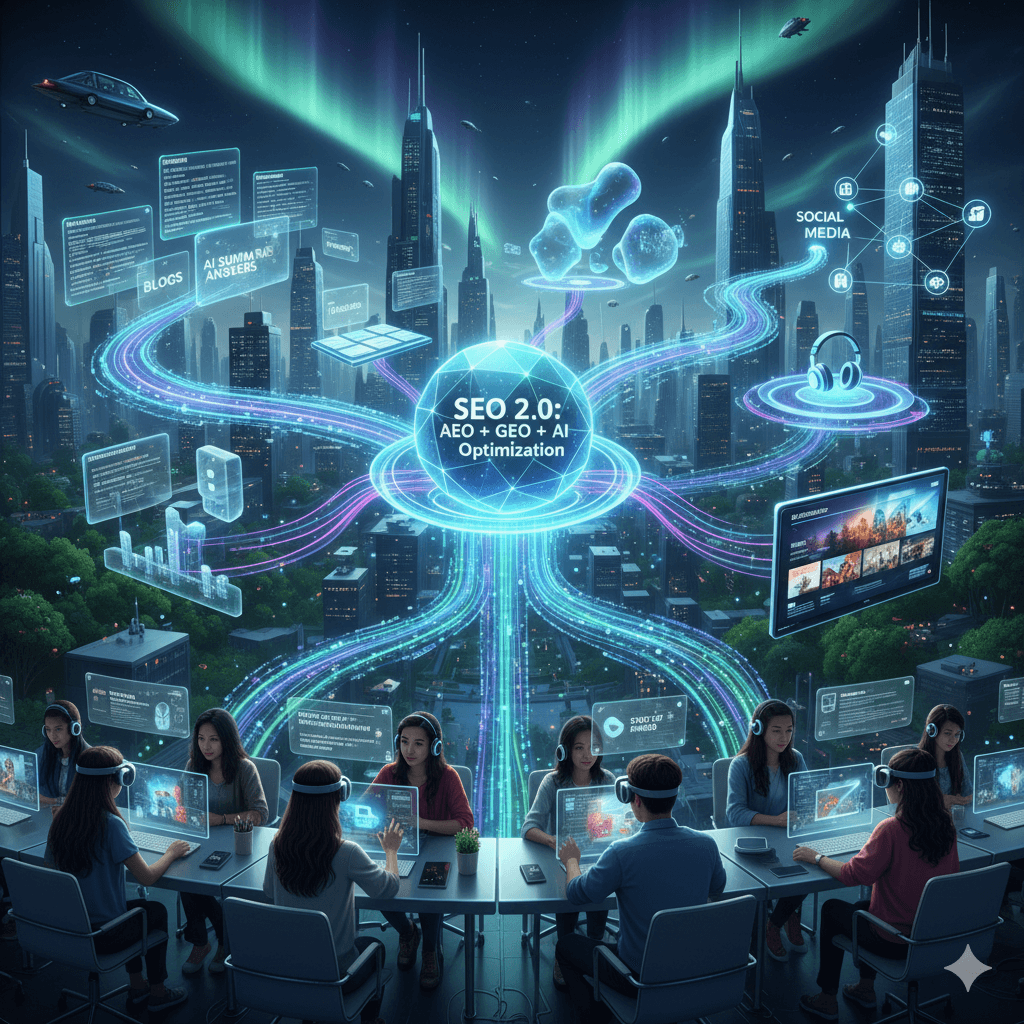
25 Nov 2025
Search Engine Optimization established itself as the core mechanism for digital discovery when it first emerged during the early 2000s. Multiple organizations including businesses and educational institutions and consulting firms used keyword optimization and backlinking and content creation as their primary methods for visibility enhancement for several years. The search engine industry experiences major changes during this current period. The modern search engine optimization environment has established AEO (Answer Engine Optimization) and GEO (Generative Engine Optimization) as its leading optimization methods.
The changes in search engine optimization do not indicate the end of SEO but rather a transformation of search optimization methods. The platform Edysor.ai stands at the forefront of this educational transformation which benefits students who want to pursue international studies.
This article explains AEO and GEO terms while showing their connection to SEO 2.0 and their impact on digital content optimization through AI. We’ll also show how Edysor.ai helps students leverage this new world of optimization while staying ahead in their study abroad journey.
At its core, SEO 2.0 is not a replacement for search engine optimization—it’s an upgrade. While traditional SEO focused largely on ranking within Google’s blue-link results, modern search is dominated by conversational AI engines, generative answers, and multi-format content delivery.
The critical difference is that instead of optimizing for a search “engine,” marketers and creators are now optimizing for a search answer.
AEO (Answer Engine Optimization) is the art of structuring content so that AI-driven platforms (Google AI Overview, ChatGPT, Perplexity, etc.) can extract, understand, and present your answers.
In practical terms:
With AEO, you are not just ranking—you’re becoming the answer.
GEO (Generative Engine Optimization) is about making your content visible within generative AI responses. Unlike AEO, where you optimize for a direct factual answer, GEO focuses on content adaptability for AI-driven outputs.
For example, if a student asks in ChatGPT:
“Which universities in UK are best for Computer Science?”
AI engines will scan GEO-optimized pages with depth, structure, and authority—selecting them for inclusion.
Together, AEO + GEO = SEO 2.0.
The rise of SEO 2.0, driven by AEO and GEO, is not just a global trend—it has unique dimensions when viewed from both the Indian and international perspectives.
In India, where over 700 million internet users are quickly adopting digital platforms, the way students and professionals consume content has changed drastically.
On the global front, adoption of SEO 2.0 is transforming how universities, edtech companies, and businesses stay visible in an AI-first world.
The Indian education system uses AI visibility to expand its operations yet the global market determines the development of AEO GEO strategies. The entire set of evidence proves that AI optimization through SEO 2.0 has become vital for businesses to stay alive in the market.
Here’s why Blog AI represents the heart of SEO 2.0:
With this AI-powered approach, you’re not just doing SEO—you’re practicing SEO 2.0.
For study abroad aspirants, the challenge isn’t just discovering information—it’s trusting the right content at the right time. That’s where Edysor.ai integrates AEO + GEO + AI optimization to support students better.
Riya who studied in Jaipur required assistance to assess Canadian Master’s program scholarship opportunities and visa application requirements. The traditional blogs presented her with an overwhelming amount of technical terminology.
The portal of Edysor.ai provided her with SEO 2.0 content that included short mindmaps and 3-minute podcasts and detailed guides which directly answered her search queries. Through the AEO and GEO strategies Edysor could show its resources directly in the AI overview.
Riya currently attends the University of British Columbia with partial scholarship funding because Edysor.ai helped her achieve SEO 2.0 visibility.
Organizations and students encountered major obstacles when searching for reliable study abroad information and developing optimized content before they started using new-age strategies like SEO 2.0.
The research findings showed that educators and students need to implement SEO 2.0 according to the presentation.
Once Edysor.ai came into action, applying AEO and GEO strategies within the SEO 2.0 framework, the outcomes changed drastically.
The users who stayed away from outdated ranking methods in SEO 2.0 earned permanent authority
AEO represents Answer Engine Optimization which involves organizing content to enable AI search engines to provide users with brief precise answers to their search inquiries.
How is GEO different from AEO?
GEO stands for Generative Engine Optimization which means your content will be embedded and cited in generative AI responses but AEO stands for Answer Engine Optimization which means being the direct factual answer.
Why is SEO 2.0 more effective for AI optimization?
SEO 2.0 uses AEO and GEO strategies to achieve dual visibility in AI instant answers and generative overviews which results in increased reach and permanent authority growth.
Which Edysor.ai feature helps convert a single blog into 10+ content formats?
The Repurposing Engine of Edysor.ai converts a single blog into various content formats including social media posts and reels and podcasts and carousels.
The content of GEO becomes accessible to generative AI tools which include ChatGPT?
The content management system GEO enables the proper collection of structured content which gets included in ChatGPT and Perplexity and Google AI Overview outputs.
Q1. The main difference between traditional SEO and SEO 2.0 exists in their search engine optimization strategies.
The main goal of SEO work demands website optimization to reach higher search engine rankings. SEO 2.0 enables your content to appear in AI-generated overviews through the combination of AEO and GEO and AI optimization techniques.
Q2. How does AEO work?
The system employs AI platforms together with search engines to enhance content delivery speed for quick answers to user questions.
Q3. How does GEO impact study abroad students?
Students who ask AI about universities and VISA processes and SOP formats receive answers that include trusted sources from Edysor.ai through GEO.
Q4. The current state of SEO 2.0 remains uncertain regarding its exclusive dependence on artificial intelligence.
Primarily, yes—it adapts SEO for the era of AI search engines, ensuring visibility in AI-summarized content.
Q5. How can Edysor.ai help me as a student?
The platform delivers AEO- and GEO-optimized study abroad content through blogs and reels and podcasts to provide you with reliable and current information.
Digital visibility now extends beyond traditional SEO because it has developed into an AI-based intelligent system. Businesses and study abroad platforms and educators can achieve complete SEO 2.0 potential through the integration of AEO and GEO. The new method provides superior results than conventional methods because it allows content to directly function as search results which improves both value and accessibility.
Organizations using SEO 2.0 technology can develop diverse content formats that transform into various types of content including blog posts and podcasts and reels and generative search results. The system delivers students and viewers dependable information which remains both timely and precise. At the same time, platforms like Edysor.ai demonstrate how applying SEO 2.0 principles reshapes the entire study abroad guidance experience—making the process simpler, smarter, and more future-proof.
Leaders who adopt SEO 2.0 will dominate the digital future while organizations that fail to do so will disappear from search engine results.
By Gunjan Pancholi, Co-Founder & AI Solutions Architect, Edysor.ai | Driving Innovation in Custom GPTs, Voice Agents & Social Bots | Product Strategist | Tech Visionary | Leading R&D in EdTech & Study Abroad Automation | Growth-Focused
LinkedIn Profile: https://in.linkedin.com/in/gunjan-pancholi-216171263
Resources
Others
All rights reserved. Powered by Edysor
